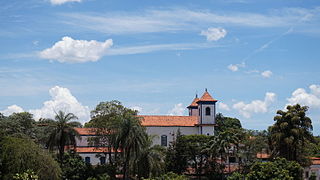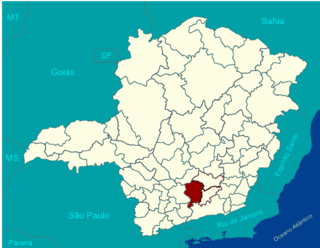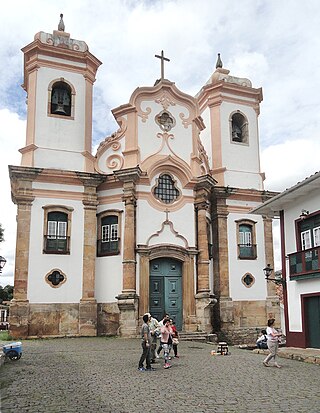
Ouro Preto, formerly Vila Rica, is a Brazilian municipality located in the state of Minas Gerais. The city, a former colonial mining town located in the Serra do Espinhaço mountains, was designated a World Heritage Site by UNESCO due to its Baroque colonial architecture. Ouro Preto used to be the capital of Minas Gerais from 1720 until the foundation of Belo Horizonte in 1897.

São João del-Rei is a Brazilian municipality in the state of Minas Gerais. Founded in 1713 in homage to king John V of Portugal, the city is famed for its historic Portuguese colonial architecture. The current population is estimated at 90,225 inhabitants.

Mineiro, Mineirês, or the Brazilian mountain accent is the Brazilian Portuguese term for the accent spoken in the Center, East and Southeast regions of the state of Minas Gerais.

Afonso Henrique da Costa Guimarães, known as Alphonsus de Guimaraens; was a Brazilian poet.

Sabará is a Brazilian municipality located in the state of Minas Gerais. The city belongs to the Belo Horizonte metropolitan region and to the associated microregion.

The Archdiocese of São Paulo is a Latin Metropolitan Archbishopric of the Catholic Church in Brazil.

Conceição da Barra de Minas is a Brazilian municipality located in the state of Minas Gerais. The city belongs to the mesoregion of Campo das Vertentes and to the microregion of Sao Joao del Rei. In 2020, the estimated population was 3,946.

The Roman Catholic Archdiocese of Belém do Pará is an archdiocese located in the city of Belém in Brazil. It covers 3,566,079 square kilometres (1,376,871 sq mi) and is organized into 80 parishes. The Archdiocese covers the municipalities of Belém, Ananindeua, Benevides, Marituba, and Santa Bárbara do Pará.

The Roman Catholic Archdiocese of Belo Horizonte is an archdiocese located in the city of Belo Horizonte in Brazil.

The Roman Catholic Archdiocese of Pouso Alegre is an archdiocese located in the city of Pouso Alegre in Brazil.

The Roman Catholic Diocese of Campanha is a diocese located in the city of Campanha in the ecclesiastical province of Pouso Alegre in Brazil.

The Roman Catholic Diocese of São João da Boa Vista is a diocese located in the city of São João da Boa Vista in the ecclesiastical province of Ribeirão Preto in Brazil.

The Basilica Shrine of Our Lady of the Immaculate Conception, also known as the Basilica Sanctuary of Our Lady of the Conception, is a temple and seat of the Roman Catholic Diocese of São João da Boa Vista in Brazil. It is under the jurisdiction of the Catholic Church in the municipality of Caconde, in the northwest region of the state of São Paulo. It is the second oldest parish of the Diocese of Boa Vista and is dedicated to Our Lady of Good Success, having been created on March 19, 1775, by order of Manuel da Resurreição, third bishop of São Paulo.

The Immediate Geographic Region of São João del-Rei is one of the 10 immediate geographic regions in the Intermediate Geographic Region of Barbacena, one of the 70 immediate geographic regions in the Brazilian state of Minas Gerais and one of the 509 of Brazil, created by the National Institute of Geography and Statistics (IBGE) in 2017.

The Immediate Geographic Region of Santa Bárbara-Ouro Preto is one of the 10 immediate geographic regions in the Intermediate Geographic Region of Belo Horizonte, one of the 70 immediate geographic regions in the Brazilian state of Minas Gerais and one of the 509 of Brazil, created by the National Institute of Geography and Statistics (IBGE) in 2017.

The Minor Basilica of Our Lady of the Pillar in Ouro Preto, Minas Gerais, popularly called the Our Lady of the Pillar Mother Church, is one of the best known Catholic buildings among those erected during the Brazilian gold rush. It is a listed monument by the National Historic and Artistic Heritage Institute (IPHAN). It is located at the Monsenhor Castilho Barbosa Square.

The Church of Our Lady of the Rosary of Black Men, also known as the Church of Our Lady of the Rosary, is a Catholic temple in Ouro Preto, Minas Gerais, Brazil. Landmarked by IPHAN, it is one of the most original sacred buildings dating from the colonial period in Brazil.



















